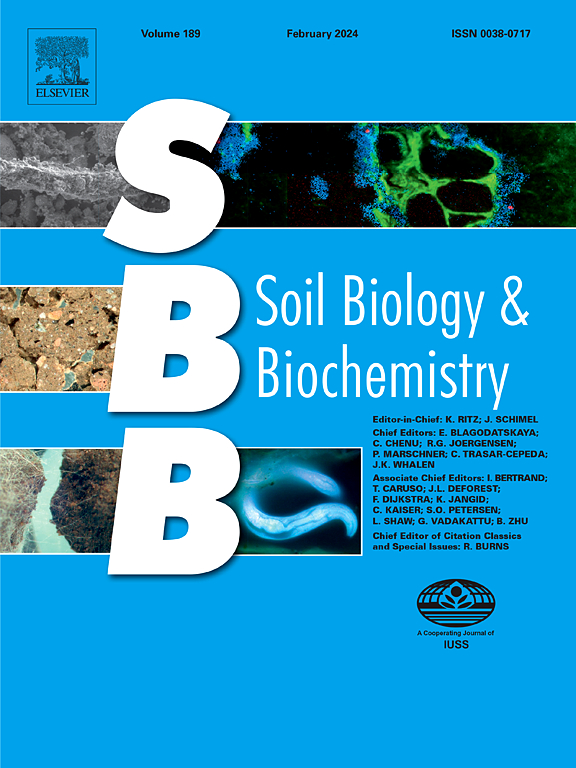参与氢循环的高亲和氧化氢土壤细菌的生态特性
IF 9.8
1区 农林科学
Q1 SOIL SCIENCE
引用次数: 0
摘要
每年,土壤微生物介导的H2氧化可去除全球大气中约75%的H2,这是一种间接温室气体。生活在土壤中的高亲和力H2氧化细菌利用这种微量气体作为能量来源,在其他底物有限的情况下维持生存,或在休眠期间满足维持能量的需求。然而,对这类细菌的分布、组成、多样性和功能,特别是它们的生态特性(即影响它们与环境和其他生物相互作用的特性)的认识是有限的。这是因为高亲和力的h2氧化细菌在系统发育上并不保守,这可能是由于它们的功能基因的水平转移,尽管这还有待正式证明。这使得我们很难回答土壤氢循环中h2氧化菌的分布、功能作用、生态贡献及其对环境因子的响应等生态学问题。这些信息是估计这组细菌对全球H2循环的贡献所必需的。虽然许多H2氧化细菌是不可培养的,但它们在响应环境变化(如pH、水分含量和H2浓度)时可能具有相似的生态特性。因此,基于群落或行会水平性状的方法(定义为分析执行类似生态角色的微生物群(行会)共享的功能性状)可以使我们合成复杂的基因组和系统发育信息。本文综述了土壤环境因子对土壤H2吸收(通过氧化)的影响,并确定了受控条件下的生态响应特征。我们的方法将H2氧化细菌的生物活性与其居住环境联系起来,以扩大和评估土壤微生物群落缓解与大气H2增加有关的全球变暖的能力。本文章由计算机程序翻译,如有差异,请以英文原文为准。
Ecological traits of high-affinity hydrogen-oxidizing soil bacteria involved in the hydrogen cycle
Every year, soil microbial-mediated hydrogen (H2) oxidation removes about 80 % of the global atmospheric H2, an indirect greenhouse gas. Soil-dwelling high-affinity H2 oxidizing bacteria use this trace gas as an energy source to persist when other substrates are limited or to meet their maintenance energy requirements during dormancy. However, there is limited knowledge of the distribution, composition, diversity, and functions of this group of bacteria, particularly their ecological traits (i.e., characteristics that influence their interactions with the environment and other organisms). This is because the high-affinity H2-oxidizing bacteria are not phylogenetically conserved, potentially due to the horizontal transfer of their functional gene, which still needs to be demonstrated. This makes it difficult to answer ecological questions related to the distribution, functional role, and ecological contribution of H2-oxidizing bacteria in the soil H2 cycle, as well as their responses to environmental factors. Such information is needed to estimate the contribution of the H2-oxidizing bacteria to the global H2 cycle. Although many H2-oxidizing bacteria are not culturable, they may share similar ecological traits when responding to environmental changes, such as pH, moisture content, and H2 concentrations. Therefore, a community or guild-level trait-based approach (defined as the analysis of functional traits shared by groups of bacteria (guilds) that perform similar ecological roles) could be useful to synthesize complex genomic and phylogenetic information. This review discusses the impact of soil environmental factors on soil H2 uptake (by oxidation), and identifies ecological response traits under controlled conditions. Our approach connects the biological activity of the H2-oxidizing bacteria to their resident environment, for scaling up and estimating the capacity of soil microbial communities to mitigate global warming linked to increased atmospheric H2.
求助全文
通过发布文献求助,成功后即可免费获取论文全文。
去求助
来源期刊

Soil Biology & Biochemistry
农林科学-土壤科学
CiteScore
16.90
自引率
9.30%
发文量
312
审稿时长
49 days
期刊介绍:
Soil Biology & Biochemistry publishes original research articles of international significance focusing on biological processes in soil and their applications to soil and environmental quality. Major topics include the ecology and biochemical processes of soil organisms, their effects on the environment, and interactions with plants. The journal also welcomes state-of-the-art reviews and discussions on contemporary research in soil biology and biochemistry.
 求助内容:
求助内容: 应助结果提醒方式:
应助结果提醒方式:


